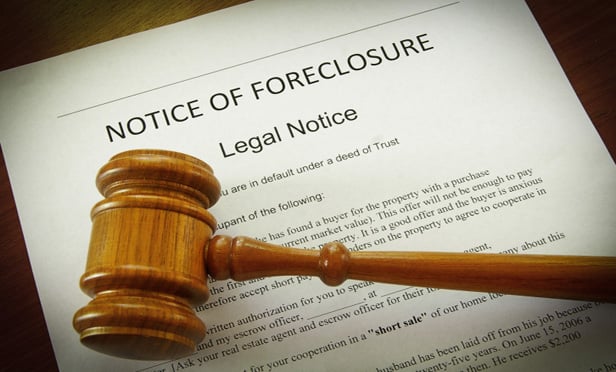Features

The False Claims Act Seal: Does It Bind and Gag the Defendant?
<b><i>Part One of a Two-Part Article</i></b><p>A company that finds itself the target of a federal fraud investigation often faces the fraught question of whether it may, or even must, disclose the existence of that investigation to third parties, such as its investors, shareholders, major creditors, or insurers. The question can be even more complicated if that investigation is being pursued under the False Claims Act and arises as the result of a sealed <i>qui tam</i> complaint.
Features

The Consequences of Imperfect Foreclosure Affirmations
Where the borrower's default is not in dispute, the First Department appears to have recognized that there is little reason to delay the inevitable foreclosure. Discussion of a case in point.
Features

Workplace Bias and Gender Pay Equity in Silicon Valley, 2017
It was only a couple of years ago that a jury rejected Ellen Pao's gender discrimination claims and rendered a defense verdict in favor of her former employer, a prominent Silicon Valley venture capital firm. Now, issues of bias and pay equity are again taking center stage, with almost daily media reports about Silicon Valley's gender problem and a continuing list of companies and notable Silicon Valley figures being taken to task with allegations of inappropriate conduct toward women.
Features

Substantive Non-Consolidation Opinion Letters: Advice for Bankruptcy Counsel
Substantive non-consolidation opinion letters have long been a regular "check-the-box" item in large commercial real estate transactions. While substantive consolidation jurisprudence has not changed materially over the past decade, these opinion letters should not be treated lightly by borrowers or their counsel.
Features

Teaching an Old Dog New Tricks: Business Process Management and Law Firms
Though traditionally considered laggards when adopting new technology, law firms have recently started to explore new tricks to fortify performance across their organizations. While this evolution is critical to a firm's survival, it's important that firm administrators understand that substantive improvements are only possible through multi-directional change.
Features

Lack of Gender-Diverse Partnership: Is It the Woman or the Firm?
<b><i>Data-Driven Research by ALM Intelligence Suggests Three Reasons Why Gender-Diverse Partnership Fails</b></i><p>It is now common knowledge that female headcount within the ranks of Big Law partnership, both equity and non-equity, has held steady for the past few years at around 20%. The obvious question is, why?
Features

Second Circuit Directs Consideration of an 'Efficient Market' Interest Rate for <b><i>Momentive</i></b> Cramdown Plan
On Oct. 20, 2017, the U.S. Court of Appeals for the Second Circuit, in Momentive Performance Materials, Inc. v. BOKF, NA (In re MPM Silicones, L.L.C. "MPM")…
Features

When Lack of Informed Consent Is Not the Issue
When an injury occurs, the first reaction of those in the medical office might be to ask, "Did the patient sign an informed consent form?" When the answer is "Yes," and the harm that occurred is listed as a possibility on that signed form, everyone can breathe a sigh of relief. Right? Not so fast.
Features

Exclusion of Evidence: The FDA's 510K Process
In a drug or medical device injury case, one of the defense's most potent arguments often is that the product in question underwent FDA approval. But when a device is approved for sale to the public through the FDA's 510(k) process, the rigorous safety and efficacy analysis required of new and unique medical devices has not been undertaken.
Features

Don't Lien on Me: Identification and Mitigation of Maritime Lien Risks in Marine Lease/Loan Transactions
This article discusses the characteristics of maritime liens, the priority of these liens in relation to the desired first-priority secured position of a lender or lessor, and prudent practices for assessing and mitigating the risks posed by such liens.
Need Help?
- Prefer an IP authenticated environment? Request a transition or call 800-756-8993.
- Need other assistance? email Customer Service or call 1-877-256-2472.
MOST POPULAR STORIES
- Use of Deferred Prosecution Agreements In White Collar InvestigationsThis article discusses the practical and policy reasons for the use of DPAs and NPAs in white-collar criminal investigations, and considers the NDAA's new reporting provision and its relationship with other efforts to enhance transparency in DOJ decision-making.Read More ›
- The DOJ's Corporate Enforcement Policy: One Year LaterThe DOJ's Criminal Division issued three declinations since the issuance of the revised CEP a year ago. Review of these cases gives insight into DOJ's implementation of the new policy in practice.Read More ›
- The DOJ's New Parameters for Evaluating Corporate Compliance ProgramsThe parameters set forth in the DOJ's memorandum have implications not only for the government's evaluation of compliance programs in the context of criminal charging decisions, but also for how defense counsel structure their conference-room advocacy seeking declinations or lesser sanctions in both criminal and civil investigations.Read More ›
- Lionsgate GC Who Resigned Without 'Good Reason' Got Severance PayAdd another plot twist to the storyline surrounding Corii Berg, who unexpectedly quit as general counsel of the film studio Lionsgate in December, even though he was under contract through June 2023.Read More ›
